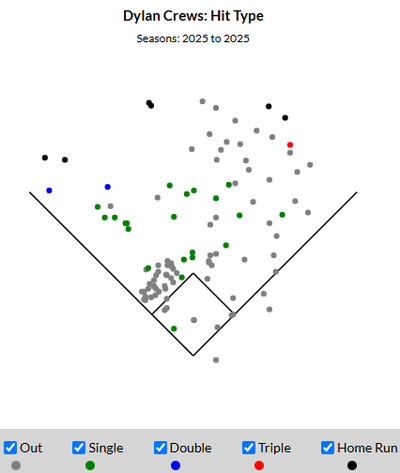
Taking a deep look into Washington Nationals Dylan Crews’ problems at the plate and what he can do to fix it
On May 14th, Dylan Crews sworded through a high fastball, then was frozen on a back foot slider to end the game. Another strikeout. Another Nationals loss, this one 5-3 to the Braves. Meaning another round of online outcry, Echoing what many in the fanbase are feeling.
Crews has stumbled badly in his first full MLB season. Crews’ .191 batting average and .588 OPS have become a daily concern. The former LSU phenom, long known as a fastball destroyer, is now hitting just .045 against heaters. His struggles against breaking pitches haven’t improved either. As other core young pieces CJ Abrams and James Wood ignite the offense, Crews remains the outlier, and his ongoing slump raises urgent questions about his swing and put’s unwanted pressure on his future.
The Numbers: From Fastball Killer to Liability at the plate
Crews’ 2024 debut showed flashes of his potential. Tallying three home runs, 12 stolen bases and a hard hit rate of 45.2%. Suggesting loud contact was incoming but Crews finished with a slash line of .218/.288/.353 and 80 wRC + in 31 games. His 2024 splits were especially troubling against breaking balls (.082 BA, 51.7% whiff rate) and off-speed pitches (.182 BA). Fastballs were his strength, he hit .297 against them with all three homers of homers coming off heaters.
In 2025, Crews has struggled showing off his ability to hit fastballs. Crews is 1 for 22 against fastballs as of May 18th at (.045), with a 22% whiff rate and seven strikeouts. Against breaking balls, the problem still lingers. His approach and pitch recognition haven’t caught up to major league arms. His .253 wOBA and 13.3% barrel rate suggest he is not generating enough consistent hard contact. especially in early counts.
Crews did have a nine game hot streak through April 27 (.351 BA, 4 HRs) hinting at a turnaround. But regression since has reopened the conversation.

The Breakdown: Mechanics, Mentality, and the MLB Learning Curve
So what is going wrong for Dylan Crews?
It starts with Crews’ swing, one thing he does have is elite bat speed (106 mph max EV, 90th percentile), but his mechanics have gotten long. His swing path has been producing too many fly balls to the opposite field and low exit velocity grounders to the pull side, both signs of a timing issue. According to analyst Matt Collier, this mechanical imbalance is leading to weaker contact and fewer barrels.
Pitchers have taken notice. They’re attacking him with more breaking balls and tying him up inside with fastballs before expanding the zone with spin away. His 36.4% chase rate is above league average (28.5%), and the results show it.
Going back to April 3rd, Hitting coach Darnell Coles believes Crews is “pressing.” The team has been working to refine his eye level and shorten his swing path to better recognize and react to pitch shapes. “He’s trying to do too much,” Coles told reporters. “We just want him to get back to seeing it and hitting it.” We are coming up on two months since this comment and Crews is still struggling.
At LSU, Crews hit .426 with a .567 OBP and compact, consistent mechanics that handled all pitch types. That swing is buried beneath the weight of major league adjustments, but glimpses still surface. In his last game on May 18th, Crews launched a 114 mph fastball dead center for a three-run shot. It was a reminder, the talent hasn’t gone anywhere.
Why This Matters for the Nationals
Crews is right in the middle of Washington’s long-term plans. He, Abrams, Wood, and MacKenzie Gore represent the core of the post-Soto era. The front office didn’t spend big this offseason, they bet on youth. That bet only works if Crews finds his footing.
The Nats rank 7th in stolen bases and have played clean defense, but they sit 24th in runs scored. Crews, with a .253 wOBA and fastball issues, he has been a black hole in the end of the lineup. Washington needs more than speed and potential. They need production.
Still, there’s reason for optimism. Crews’ 29.3 ft/sec sprint speed ranks in the top 7% of MLB. His glove has already earned Gold Glove attention. And his April surge showed what happens when he slows the game down.
He’s been exploited by breaking balls since his debut, but now even fastballs are an issue. His long swing, high chase rate, and declining confidence have neutralized his power. But the tools, bat speed, athleticism, contact skills are all still there. His recent hot streak shows there’s a hitter waiting to break through.
The Nationals need him to find that gear. Whether it’s a mechanical adjustment, a mental reset, or more time to grow, Crews is too important to fade into the background.